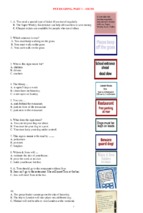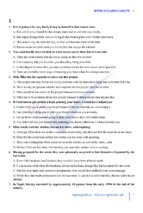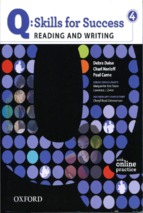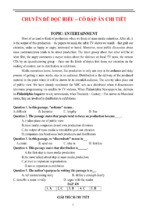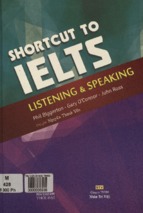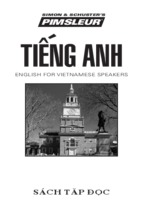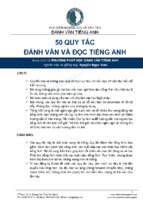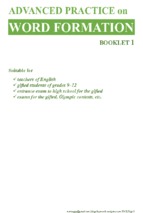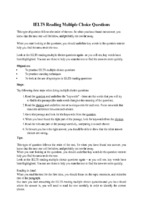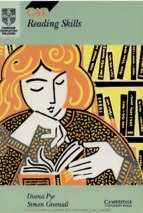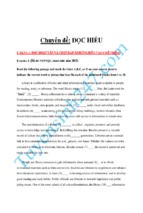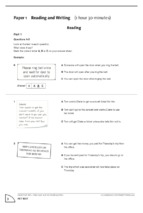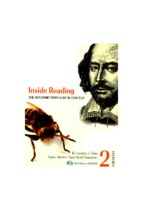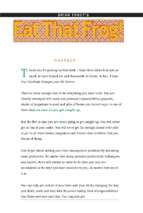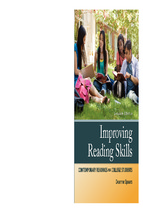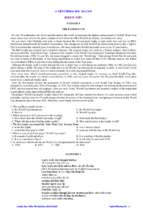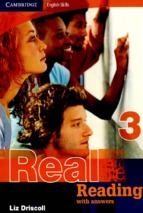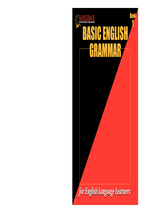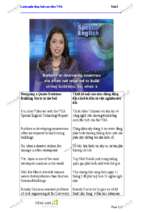Học toán bằng Tiếng Anh - có đáp án (8 practice tests for reading and maths) dùng cho học sinh lớp 7 và 8
8 Practice Tests
for
Reading and Math
Grades 7–8
by Michael Priestley
New York • Toronto • London • Auckland • Sydney •
Mexico City • New Delhi • Hong Kong • Buenos Aires
8 Practice Tests for Reading and Math: Grades 7-8 © Michael Priestly, Scholastic Teaching Resources
Scholastic Inc. grants teachers permission to photocopy the designated reproducible pages from this book for
classroom use. No other part of this publication may be reproduced in whole or in part, or stored in a retrieval
system, or transmitted in any form or by any means electronic, mechanical, photocopying, recording or
otherwise, without written permission of the publisher. For information regarding permission, write to
Scholastic Inc., 555 Broadway, New York, NY 10012.
Cover design by Kelli Thompson
Interior design by Creative Pages Inc.
Interior illustrations by Teresa B. Southwell
ISBN 0-439-33822-0
Copyright © 2002 by Michael W. Priestley. All rights reserved.
Printed in the U.S.A.
8 Practice Tests for Reading and Math: Grades 7-8 © Michael Priestly, Scholastic Teaching Resources
Contents
Introduction . . . . . . . . . . . . . . . . . . . . . . . . . . . . . . . . . . . . . . . . . . . . . . . . . 4
Test-Taking Tips for Reading . . . . . . . . . . . . . . . . . . . . . . . . . . . . . . . . . . . 5
Test-Taking Tips for Math . . . . . . . . . . . . . . . . . . . . . . . . . . . . . . . . . . . . . . 6
Practice Test 1 . . . . . . . . . . . . . . . . . . . . . . . . . . . . . . . . . . . . . . . . . . . . . 7
Practice Test 2 . . . . . . . . . . . . . . . . . . . . . . . . . . . . . . . . . . . . . . . . . . . . 17
Practice Test 3 . . . . . . . . . . . . . . . . . . . . . . . . . . . . . . . . . . . . . . . . . . . . 27
Practice Test 4 . . . . . . . . . . . . . . . . . . . . . . . . . . . . . . . . . . . . . . . . . . . . 37
Practice Test 5 . . . . . . . . . . . . . . . . . . . . . . . . . . . . . . . . . . . . . . . . . . . . 47
Practice Test 6 . . . . . . . . . . . . . . . . . . . . . . . . . . . . . . . . . . . . . . . . . . . . 57
Practice Test 7 . . . . . . . . . . . . . . . . . . . . . . . . . . . . . . . . . . . . . . . . . . . . 67
Practice Test 8 . . . . . . . . . . . . . . . . . . . . . . . . . . . . . . . . . . . . . . . . . . . . 77
Answer Sheet . . . . . . . . . . . . . . . . . . . . . . . . . . . . . . . . . . . . . . . . . . . . . . . 87
Tested Skills (by test) . . . . . . . . . . . . . . . . . . . . . . . . . . . . . . . . . . . . . . . . 88
Answer Keys . . . . . . . . . . . . . . . . . . . . . . . . . . . . . . . . . . . . . . . . . . . . . . . 92
8 Practice Tests for Reading and Math: Grades 7-8 © Michael Priestly, Scholastic Teaching Resources
Introduction
In this book, you will find eight Practice Tests designed to help your students prepare to take
standardized tests. Each Practice Test has two parts—Reading and Math. Each test part has 20–32
multiple-choice items that closely resemble the kinds of questions students will have to answer on
“real” tests. Each part of the test will take 30–40 minutes for students to complete.
The Reading and Math skills measured in these tests and the types of questions are based on detailed
analyses and correlations of the five most widely used standardized tests and the curriculum standards
measured by many statewide tests, including the following:
Stanford Achievement Test
CTBS TerraNova
Metropolitan Achievement Test
Iowa Test of Basic Skills
California Achievement Test
California’s STAR Test
TAAS (Texas)
MCAS (Massachusetts)
FCAT (Florida)
New York
How to Use the Tests
To use a Practice Test, make a copy of the test or part of the test for each student. Tell students how
much time they will have to complete the test. Encourage students to work quickly and carefully and to
keep track of the remaining time—just as they would in a real testing session. You may have students
mark their answers directly on the test pages, or you may have them use a copy of the Answer Sheet
on page 87. The answer sheet may be used with any of the Practice Tests, and it will help students
become accustomed to filling in bubbles on a separate answer sheet. It may also make the tests easier
for you to score.
For the Math section in each test, we do not recommend the use of calculators. For Practice Tests 2
and 6, students will need an inch ruler and a centimeter ruler to answer some of the questions.
At the back of this book, you will find Tested Skills charts and Answer Keys for the eight Practice
Tests. The Tested Skills charts list the skills measured in each test and the test questions that measure
each skill. These charts may be helpful to you in determining what kinds of questions your students
answered incorrectly, what skills they may be having trouble with, and who may need further
instruction in particular skills. To score a Practice Test, refer to the Answer Key for that test. The
Answer Key lists the correct response to each question.
To score a Practice Test, go through the test and mark each question answered correctly. Add the total
number of questions answered correctly to find the student’s test score. To find a percentage score, divide
the number answered correctly by the total number of questions. For example, the percentage score for
a student who answers 20 out of 25 Reading questions correctly is 20 � 25 � 0.80, or 80%. In your
classroom, you might want to have students correct their own tests. This will give students a chance to
see where they made mistakes and what they need to do to improve their scores on the next test.
On the next two pages of this book, you will find Test-Taking Tips for Reading and Math. You may
want to share these tips and strategies with students before they begin working on the Practice Tests.
You may also want to post these tips in the classroom and discuss them when students are preparing to
take tests.
4
8 Practice Tests for Reading and Math: Grades 7-8 © Michael Priestly, Scholastic Teaching Resources
Test-Taking Tips: Reading
1. For each part of the test, read the directions carefully so you know what to do.
Then read the directions again—just to make sure.
2. For questions about a reading passage, take a quick look at the questions first.
Then you will know what to look for as you read the passage.
3. In each question, look for key words to help you decide what the question is
asking. Examples of key words: who, what, when, where, how, why.
4. You do not have to memorize the information in each passage before you answer
the questions. Go back to the passage to find the answers you need.
5. To find the sequence of events, look for signal words, such as first, last, then, next,
before, after, later, finally. You may also look for numbers, such as years or dates.
6. To figure out the meaning of an unfamiliar word in a passage, look for clues in the
sentence. Be sure to look in the sentences before and after the word, too.
7. To find causes and effects, look for signal words and phrases, such as because, so,
since, as a result.
8. When answering a question, read all the answer choices carefully. Consider each
possible answer before you choose one.
9. To find the main idea of a passage, decide what the whole passage is mostly about.
Use the title and any pictures on the page to help you figure it out.
10. Be on the lookout for negative words in questions or directions, such as not,
opposite, except, unless. These words may be in all CAPITAL letters, in bold type
or italics, or underlined. Questions using these words can be confusing. Think
carefully about what the question is asking before you choose an answer.
8 Practice Tests for Reading and Math: Grades 7-8 © Michael Priestly, Scholastic Teaching Resources
5
Test-Taking Tips: Mathematics
1. For each part of the test, read the directions carefully so you know what to do.
Then read the directions again—just to make sure.
2. Look for key words and phrases to help you decide what each question is asking
and what kind of computation you need to do. Examples of key words: less than,
greatest, least, farther, longest, divided equally.
3. To help solve a problem, write a number sentence or equation.
4. Use scrap paper (or extra space on the test page) to write down the numbers and
information you need to solve a problem.
5. If a question has a picture or diagram, study it carefully. Draw your own picture or
diagram if it will help you solve a problem.
6. Try to solve each problem before you look at the answer choices. (In some tests,
the correct answer may be “Not Given” or “Not Here,” so you will want to be sure
of your answer. In these Practice Tests, some of the Math questions use “NG” for
“Not Given.”)
7. Check your work carefully before you finish. (In many questions, you can check
your answer by working backwards to see if the numbers work out correctly.)
8. If you are not sure which answer is correct, cross out every answer that you know
is wrong. Then make your best guess.
9. To complete a number sentence or equation, try all the answer choices until you
find the one that works.
10. When working with fractions, always reduce (or rename) the fractions to
their lowest parts. When working with decimals, keep the decimal points lined
up correctly.
6
8 Practice Tests for Reading and Math: Grades 7-8 © Michael Priestly, Scholastic Teaching Resources
Name
Date
Practice Test 1
Reading
Directions. Choose the meaning of the
underlined word. Mark your answer.
7. Excavation means —
A
B
1. Boisterous means —
A
B
C
D
afraid
nervous
noisy
thoughtful
C
D
8. Presidential means —
F
G
2. Peril means —
F
G
H
J
danger
amazement
weakness
beauty
H
J
A
B
C
D
quiet
controlling
bashful
clever
4. A villa is a —
F
G
H
J
kind of tree
dessert
country estate
small town
5. Literal means —
A
B
C
D
unfair
actual
knowledgeable
educated
6. To forfeit means to —
F
G
H
J
the state of being president
of or like a president
a person who is president
without the president
9. Transcontinental means —
A
B
3. Someone who is dominant is —
the act of excavating
without excavating
a person who excavates
before excavating
C
D
after the continent
below the continent
across the continent
against the continent
Directions. Choose the best answer to each
question about root words. Mark your answer.
10. Which word most likely comes from the
Latin word canem, meaning “dog”?
candle
F
G cane
H canine
J
cancel
11. Which word most likely comes from the
French word glace, meaning “ice”?
A glacier
B glass
C glamorous
D glad
escape
study
slow down
give up
8 Practice Tests for Reading and Math: Grades 7-8 © Michael Priestly, Scholastic Teaching Resources
GO ON
7
Name
Date
Practice Test 1 (continued)
Directions. Read each passage. Choose the best answer to each question. Mark your answer.
A Narrow Escape
Cody woke up and groaned. He’d been having a really strange dream about being
in a room with sterile white walls, doctors, nurses, and shots. “Weird dream,” he
thought, relieved that it was over.
Then he opened his eyes and was blinded by glaring white light. He cringed and
closed his eyes again. Then he opened them one at a time, slowly, but the light
made his head ache. “Uh-oh,” Cody thought as the room came into focus. His
dream hadn’t been a dream at all. Where was he, and what was he doing here? He
tried to remember as a robo-nurse came in and began checking the machines in the
room. Not ready to face the situation just yet, he pretended he was still asleep.
Cody wracked his brain to try to remember how he’d gotten here. He’d been on
the subway when an older guy had approached him and whispered, “Run, boy,
run!” Cody figured the man was disturbed, but when the train stopped at the next
station, three men in silver suits entered the car. Cody saw them coming toward him
and knew he should do what the old man had said, but it was too late by then. The
three men had him surrounded.
“What do you want from me?” Cody demanded, but he already knew that they
wanted information. One of the men raised his arm slightly, and Cody was dazzled by
the brightest flash of light he’d ever seen. That was the last thing he remembered.
“Great,” Cody thought to himself, “just great.” He’d gotten careless and forgotten
all his training as a secret agent. He was carrying information on a data chip in his
head that would help free the world from the Dictator, but he’d let his guard slip
and now he was in a real mess.
When the robo-nurse left the room, Cody silently swung his feet over the side of
the bed. He looked around and peered at the windows, noticing to his dismay that
they were covered by ironwork. It would have to be the door. He was wearing light
hospital pajamas and no shoes, but there was no time to search for his clothes now.
Cody crept to the doorway and swiveled his head from left to right. There wasn’t
a soul in the hall, so he sneaked down to the stairway. Suddenly, just as he reached
the second floor, an alarm shrieked. He pelted down the staircase, out the door, into
the lobby. A security officer shouted at him and tried to close a barrier over the
door, but Cody squeezed through at the last minute, running for his life. He ran as
fast and furiously as he could. He heard shouts behind him as the gates ahead began
to close, and his eyes scanned the wall for another exit. Out of the corner of his eye,
he spotted it—a hole to the right of the gate. He veered off the gravel and over the
grass, ducked down, and pushed through the tall hedge until he was free.
GO ON
8
8 Practice Tests for Reading and Math: Grades 7-8 © Michael Priestly, Scholastic Teaching Resources
Name
Date
Practice Test 1 (continued)
A car screamed to a halt in front of Cody and the passenger door swung open.
“Get in!” called the driver. “Hurry!” Cody recognized him as the old man from the
train. He paused. “In the car now, you can ask questions later!” the old man urged.
Cody got into the car and the old man stepped on the gas.
“It’s about time you showed up,” the old man grumbled.
Suddenly, Cody remembered who the old man was. “Thanks, Gramps,” he said.
The old man just grunted, but Cody knew he was pleased. They traveled in silence,
as if they were just a regular old man and a boy, not freedom fighters on the way to
save the world.
12. When does this story take place?
during the 1800s
F
G in the present
H during World War II
J
in the future
13. What happened soon after Cody woke up?
A He escaped from the hospital.
B He got on the subway.
C An old man warned him.
D Three men surrounded him.
14. What will Cody and Gramps most likely
do next?
They will drive back to the hospital to
F
find information.
G They will go to the subway to hide.
H They will meet up with other
freedom fighters.
J
They will go to talk to the Dictator.
15. You can tell from this passage that —
A Gramps is the leader of the
freedom fighters
B Cody had lost part of his memory
C the guards at the hospital will get
Cody back
D Cody and Gramps are both robots
16. How does Gramps feel toward Cody in
this story?
resentful
F
G afraid
H protective
J
jealous
17. What kind of passage is this?
A realistic fiction
B informative article
C biography
D science fiction
18. In this story, who was the most serious
threat to Cody?
Gramps
F
G the nurse
H the hospital guards
J
the Dictator
GO ON
8 Practice Tests for Reading and Math: Grades 7-8 © Michael Priestly, Scholastic Teaching Resources
9
Name
Date
Practice Test 1 (continued)
My Brother and the Song That Doesn’t End
That song was my brother’s favorite way to drive me to the brink. You probably
know the ditty, which goes something like, “This is the song that doesn’t end/Yes, it
goes on and on, my friend/Some people started singing it, not knowing what it
was/And they’ll continue singing it forever just because—.” Then it repeats over and
over again because, of course, it’s the song that doesn’t end.
Anyway, my kid brother Jake used to drive me bananas with his rendition of that
song. Anytime he wanted something or just felt like being a pest, he’d parade past
my room singing it loudly until I surrendered. My brother’s seven years younger
than I am, so I guess he craves attention. My mom says he looks up to me, but he
sure has a peculiar way of showing it!
My brother and his song came in handy one day, though, when I had a conflict
with our neighbor. This guy was the crabbiest grouch you’ve ever seen. If you so
much as whistled when you walked by his house, he’d stomp out on the porch and
yell at you for making too much commotion. My friend Genevieve approached his
walk one time to try to sell him a magazine subscription, and he came out and
threatened to have her arrested!
So anyway, I was riding my bike outside Mr. Grouch’s house when the brakes
failed big-time. There was nothing I could do, so I crashed through his gate and
onto his walk. It was only seconds before he dashed out of the house screaming at
me. I was dazed and all scraped up, but he didn’t care. He just grabbed my bike
and stormed back into his house.
“Hey!” I yelled. “That’s my bike! Give it back!”
“It’s on my property, so it’s MY bike now,” he roared as he slammed the door.
I couldn’t believe it. The guy had actually stolen my bike! Try as I might, I
couldn’t think of a way to get it back, either. Then a couple of days later as I sat in
my room sulking, I heard a terrible racket. I looked out the window, and there was
Jake, marching back and forth in front of the neighbor’s house. He was banging a
garbage can lid and singing at the top of his lungs, “This is the song that doesn’t
end/Yes, it goes on and on, my friend—”
“What’re you trying to do, drive me crazy?” screamed the neighbor.
“Yep,” said Jake, “and I’ll keep doing it until you return my brother’s bike.”
He was out there a good half hour, singing his heart out, before the door opened
a crack and my bike flew down the stairs and onto the sidewalk. I watched as Jake
ran to grab it and wheeled it down the street back to our house.
“Andrew, I got your bike back,” he said as he came in the house.
GO ON
10
8 Practice Tests for Reading and Math: Grades 7-8 © Michael Priestly, Scholastic Teaching Resources
Name
Date
Practice Test 1 (continued)
“Yeah, I noticed,” I said, smiling. “You know something? You’re all right.”
He just grinned at me. “So do you want to take me to a movie?” he asked.
“Sure thing!” I laughed.
After that, I realized that my brother wasn’t so bad after all. I mean, he is a pest
sometimes, but in a crunch, I’d rather have him on my side any day!
19. Which of these events happened last?
A Jake sang in front of Mr. Grouch’s house.
B Genevieve went to Mr. Grouch’s house.
C Jake came home with Andrew’s bike.
D Andrew crashed through Mr. Grouch’s
gate.
22. According to Andrew, the neighbor was —
mean
F
G helpful
H kind
J
selfish
20. When Jake started singing on the
sidewalk, you could predict that —
Jake would be arrested
F
G Mr. Grouch would call the police
H Jake would drive the neighbor crazy
J
Andrew would rescue his little brother
23. This story is told from whose point
of view?
A Andrew’s
B the mother’s
C Jake’s
D the neighbor’s
21. You can tell from this passage that —
A Andrew wishes he had more brothers
B Jake does not know how to ride a bike
C the neighbor used to be a nice guy
D Andrew and his family live in a suburban
neighborhood
24. As far as Andrew was concerned, what
was the best thing Jake did?
He banged a garbage can lid.
F
G He paraded past Andrew’s room.
H He got the bike back.
J
He sang a song that did not end.
STOP
8 Practice Tests for Reading and Math: Grades 7-8 © Michael Priestly, Scholastic Teaching Resources
11
Name
Date
Practice Test 1
Mathematics
Directions. Choose the best answer to each question. Mark your answer.
1. This chart shows the numbers of dogs
registered for 4 of the top 10 breeds
in 2000.
Breed of Dog
Number Registered
Beagle
52,026
Dachshund
54,773
German Shepherd
57,660
Poodle
45,868
Which breed had the most dogs registered?
A beagle
B dachshund
C German shepherd
D poodle
2. Mickie has a raffle ticket. One of the digits
on the ticket is smudged.
RAFFLE
TICKET
1 6 8
3. Which is a prime number?
A 27
B 39
C 45
D 53
4. The sun is about 93 � 106 miles from
the earth. What number does 93 � 106
represent?
9300
F
G 93,000
H 9,300,000
J
93,000,000
5. The world land speed record is 763.035
miles per hour. What is that number
rounded to the nearest hundredth?
A 763.0
B 763.04
C 763.1
D 764
3 4
What is the place value of the digit that
is missing?
tens
F
G hundreds
H thousands
J
ten thousands
6. Which number best completes the number
pattern below?
5, 7, 10, 14, _____, 25, 32
F
G
H
J
17
18
19
20
GO ON
12
8 Practice Tests for Reading and Math: Grades 7-8 © Michael Priestly, Scholastic Teaching Resources
Name
Date
Practice Test 1 (continued)
7. Light travels at a speed of about 299,800
kilometers per second. What is the place
value of the “2” in this number?
A thousands
B ten thousands
C hundred thousands
D millions
8. The deepest part of the Pacific Ocean is
about 37,000 feet deep. How can this
number be written using expanded notation?
3.7 � 104
F
5
G 3.7 � 10
4
H 37 � 10
J
37 � 102
10. This chart shows the populations of
four countries.
Country
Population
El Salvador
6,122,515
Honduras
6,249,598
Haiti
6,867,995
Nicaragua
4,812,569
Which country has the largest population?
El Salvador
F
H Haiti
G Honduras
J
Nicaragua
11. Which number comes next in this
number pattern?
1.25, 2.50, 3.75, 5.00, ____
9. The country of Vietnam has an area of
127,246 square miles. What is that number
rounded to the nearest thousand?
A 126,000
B 127,000
C 127,200
D 130,000
A
B
5.25
5.75
C
D
6.25
6.50
12. Over four weeks, members of the local
Bug Club saw these bugs.
Ants
Spiders
Bees
Butterflies
1123
979
512
478
About how many bugs did they see
all together?
3500
F
G 3000
H 2500
J
2000
GO ON
8 Practice Tests for Reading and Math: Grades 7-8 © Michael Priestly, Scholastic Teaching Resources
13
Name
Date
Practice Test 1 (continued)
13. What is the least common multiple of
4 and 6?
A 2
B 10
C 12
D 24
16. Look at the number line. Which integer
does the letter Z represent?
–5
F
G
H
14. What is the greatest common factor of
16, 20, and 32?
8
F
G 6
H 4
J
2
15. The list below shows the average
temperatures in Missoula, Montana, for
four days.
J
Which day had the lowest temperature?
A Saturday
B Sunday
C Monday
D Tuesday
A
C
D
3
5
–2
–1
1
2
1
��
6
1
��
3
1
��
2
2
��
3
18. Ms. Zellner’s students took a survey about
class pets. Of the 24 students in the class,
12 students had dogs, 14 had cats, 8 had
hamsters, and 6 had birds. What fraction
of the class had birds?
F
G
H
J
14
Z 0 X
17. What part of the figure below is shaded?
B
Average Temperatures
Saturday
–3°F
Sunday
4°F
Monday
2°F
Tuesday
–5°F
–3
1
��
4
1
��
3
7
��
12
5
��
8
8 Practice Tests for Reading and Math: Grades 7-8 © Michael Priestly, Scholastic Teaching Resources
GO ON
Name
Date
Practice Test 1 (continued)
6
19. Which fraction is equivalent to �8�?
A
B
1
��
2
2
��
3
C
D
4
��
6
3
��
4
20. Adam kept track of the growth of a plant
for four weeks. The chart below shows
the results.
Week
1
2
3
4
4
23. Which decimal number is equal to �5�?
A 0.20
B 0.40
C 0.50
D 0.80
24. Martin ran the 100-meter dash 4 times.
His times are listed below.
Amount Plant Grew
Race
Time
3
�� in.
8
5
�� in.
16
1
�� in.
4
5
�� in.
8
1
13.41 sec
2
13.49 sec
3
13.50 sec
4
13.45 sec
During which week did the plant grow
the most?
Week 1
F
H Week 3
G Week 2
J
Week 4
36
In which race did Martin have the
fastest time?
Race 1
F
G Race 2
H Race 3
J
Race 4
21. Which is another way to write �8�?
1
A
4 �2�
B
4 �4�
1
1
C
4 �8�
D
3 �8�
6
22. Mr. Johnson got a check for $398.75.
1
He put �4� of that amount in the bank. Which
1
is the best estimate for �4� of $398.75?
$40
F
G $75
H $100
J
$200
25. One-fifth of Mr. Singh’s students are
absent because they have the flu. What
percentage of the students are absent?
A 20%
B 25%
C 50%
D 80%
GO ON
8 Practice Tests for Reading and Math: Grades 7-8 © Michael Priestly, Scholastic Teaching Resources
15
Name
Date
Practice Test 1 (continued)
26. On the number line below, the arrow
points to what number?
–1
F
G
H
J
0
1
1
��
4
1
��
8
2
��
7
5
��
8
29. If s and t are whole numbers, and t � 1,
then which expression must be true?
A s�t�s
B s�t�1
C s�t�s
D s�t�1
30. Which expression is equivalent to
(n � 10) � 5?
F
G
H
J
27. In Martina’s class of 30 students,
18 students can speak Spanish. What
fraction of the students can speak Spanish?
A
B
C
D
1
��
2
3
��
5
2
��
3
3
��
4
(n � 5) � 10
(n � 5) � (10 � 5)
(n � 5) � 10
(n � 10) � 5
31. (0.25 � 0.50)10 � 0 �
A 0
B 2.5 � 5.0
C 0.75 � 10
D 0 � 0.75
32. Look at the list below.
28. If a � b � 0, which other number sentence
is true?
b�a�0
F
G a�0�b
H a–b�0
J
b�0�a
W�0
X � �5
Y � �1
Z � 0.50
Which letter has the greatest number value?
W
F
G X
H Y
J
Z
STOP
16
8 Practice Tests for Reading and Math: Grades 7-8 © Michael Priestly, Scholastic Teaching Resources
Name
Date
Practice Test 2
Reading
Directions. Read the two sentences. Choose the word that best fits in both sentences.
Mark your answer.
1. Jackie is very well informed about
events.
Marco had a tough time paddling the
canoe upstream against the
.
A recent
B news
C flow
D current
4. Patty owes me twenty dollars plus
I have no
extra
F
G concern
H stock
J
interest
.
in that particular subject.
5. Timmy clapped as the figure skater began
to
.
2. Don’t
Martha about her braces
anymore!
They have three sheep, a billy goat, and a
in the barn.
kid
F
G tease
H ram
J
horse
Dad took us out for a
A ride
B trip
C spin
D rotate
6. Masha bought a
a new coat.
3. World War I was a dark
European history.
I’ve got math during the third
on Friday.
A stage
B period
C event
D reminder
in
Remember to
to bed.
piece
F
G lock
H bolt
J
roll
in his new car.
of red fabric to make
the door before you go
GO ON
8 Practice Tests for Reading and Math: Grades 7-8 © Michael Priestly, Scholastic Teaching Resources
17
Name
Date
Practice Test 2 (continued)
Directions. Read each passage. Choose the best answer to each question. Mark your answer.
Man’s Best Friend?
Typically, dogs have been called “man’s best friend” because of their important
role in human lives. However, the robot may soon succeed the dog as the human’s
closest companion. Robots are doing everything from entertaining us to working for
us to saving our lives.
More people notice robots these days because they have become more visible in
the media. There are a few TV shows where robot inventors fight their robots, for
example, or robots become super crime fighters, but robots have much more
important jobs in our world. Since the late 1950s, robots have been used in many
kinds of manufacturing, especially in those jobs in factories that involve repeating
the same action over and over again. People get tired or bored in such a situation,
but robots do not. Robots can do the same things many thousands of times a day,
every day—something people simply can’t do.
Robots aren’t just stuck on the assembly line. Scientists are making robots that are
more careful than ever. Some can even work on small circuits for electronics.
Robots do dangerous jobs, too. They can find and get rid of bombs, for
example—a job that’s not safe for people. Bomb robots have arms that lift the
bombs and place them into bombproof boxes. In places that have been
contaminated by germs, chemicals, or radioactivity, robots are invaluable because
they can go where humans cannot.
Robots aren’t all work and no play. They’ve become so sophisticated that some
people even use them as pets! Robotic dogs and cats are on the market now. While
some perform only the simplest functions, others are capable of learning tricks and
obeying commands!
Robots will doubtless become even more important in society as we become
better at making them. Soon they will become widespread in hospitals
where they will perform delicate
surgery requiring a hand so
steady that a human couldn’t do
the procedure. Scientists are also
in the early stages of developing
artificial intelligence in robots,
which would allow them to
interact fully with humans. That’s
when robots may become a
human’s best friend.
GO ON
18
8 Practice Tests for Reading and Math: Grades 7-8 © Michael Priestly, Scholastic Teaching Resources
Name
Date
Practice Test 2 (continued)
7. The passage mentions places that
have been contaminated. The word
contaminated means —
A saved; preserved
B rebuilt
C infected; polluted
D torn down
8. Today’s robots are valuable to humans
mainly because they —
can do jobs that people cannot do
F
G are entertaining
H are smarter than people
J
do not require food or sleep
9. In factory work, people are often less
efficient than robots because —
A robots enjoy what they do
B people get tired and bored
C factories are very dark
D people are paid less than robots
11. Most of the information in this article is
organized by —
A main idea and supporting details
B cause and effect
C chronological order
D comparison and contrast
12. Which would be the best source
of information about robots used
in manufacturing?
the Internet
F
G an atlas
H a science textbook
J
an almanac
13. Which sentence states a fact?
A Dogs play very important roles in
our lives.
B The most exciting shows on TV feature
robots as super crime fighters.
C Robots will soon become a human’s
best friend.
D Since the late 1950s, robots have been
used in many kinds of manufacturing.
10. What is the main idea of the passage?
Robots are better than people.
F
G Robots make good pets.
H Robots serve many different functions
today.
J
We don’t have much use for robots yet.
GO ON
8 Practice Tests for Reading and Math: Grades 7-8 © Michael Priestly, Scholastic Teaching Resources
19
- Xem thêm -

